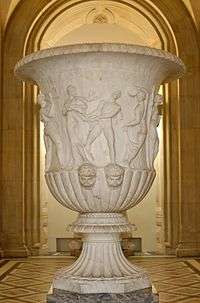Gardens of Sallust
The Gardens of Sallust (Latin: Horti Sallustiani) were Roman gardens developed by the Roman historian Sallust in the 1st century BC. The landscaped pleasure gardens occupied a large area in the northwestern sector of Rome, in what would become Region VI, between the Pincian and Quirinal hills, near the Via Salaria and later Porta Salaria. The modern rione is now known as Sallustiano.
History
The property originally belonged to Julius Caesar as the Horti Caesaris, but after his death it was acquired by the historian, Sallust, who developed it using his wealth extorted as governor of the province of Africa Nova (newly conquered Numidia). After the writer's great-nephew it passed to Tiberius in 20 AD and was maintained for several centuries by the Roman Emperors as a public amenity. The Emperor Nerva died of a fever in a villa in the gardens in AD 98, and it remained an imperial resort until it was sacked in 410 by the Goths under Alaric, who entered the city at the gates of the Horti Sallustiani. The complex was severely damaged and never rebuilt[1] However, the gardens were not finally deserted until the 6th century.[2] In the early 17th century Cardinal Ludovico Ludovisi, nephew of Pope Gregory XV, purchased the site and constructed the Villa Ludovisi, in the course of which several important Roman sculptures were rediscovered. Much of the area occupied by the gardens was divided into building lots and filled following the break-up of Villa Ludovisi after 1894, as Rome expanded as the capital city of Italy after the unification of Italy. The ancient topography itself has been irrevocably altered with the filling of the valley between the Pincio and Quirinal hills where these horti existed.[3]
Art
The gardens, which were enriched with many additional structures in the four centuries during which they evolved, contained many pavilions, a temple to Venus, a porticus of a thousand paces, and monumental sculptures. Items later found in the gardens include:
- the Obelisco Sallustiano, a Roman copy of an Egyptian obelisk which now stands in front of the Trinità dei Monti church above the Piazza di Spagna at the top of the Spanish Steps
- the Borghese Vase, discovered there in the 16th century.
- the sculptures known as the Dying Gaul and the Gaul Killing Himself and His Wife
- the Ludovisi Throne, found in 1887, and the Boston Throne, found in 1894.
- the Crouching Amazon, found in 1888 near the via Boncompagni, about twenty-five meters from the via Quintino Sella (Museo Conservatori).
Remains
A remarkably well preserved pavilion of the villa can be seen at the center of present-day Piazza Sallustio. The pavilion originally stood at the garden's summit on a spectacular location. Its main feature is a circular hall roofed by a dome.
Remains of a cryptoporticus were discovered in constructing the garage of the American Embassy on Via Friuli. A large cistern survives under Collegio Germanico at the corner of Via San Nicola da Tolentino and Via Bissolati.[4]
Gallery of sculptures found on the site of the gardens


 Dying Galatian, sometimes called The Dying Gladiator at the Capitoline Museum entered by way of the Campidoglio
Dying Galatian, sometimes called The Dying Gladiator at the Capitoline Museum entered by way of the Campidoglio Ludovisi Throne (Palazzo Altemps)
Ludovisi Throne (Palazzo Altemps)
See also
Notes
References
- Samuel Ball Platner and Thomas Ashby, 1929. A Topographical Dictionary of Ancient Rome, (Oxford University Press): Horti Sallustiani
- Kim J. Hartswick, 2004. The Gardens of Sallust: A Changing Landscape (University of Texas Press) Reviewed by Eric M. Moormann, Bryn Mawr Classical Review, 20 The first monograph on the subject, covering topography and history, architecture and sculpture.
- The Gardens of Sallust from Platner/Ashby's Topographical Dictionary
- Filippo Coarelli: Rome and Environs. An Archaeological Guide. University of California Press, 2007. pp. 242–244
External links
Coordinates: 41°54′18″N 12°29′22″E / 41.90500°N 12.48944°E